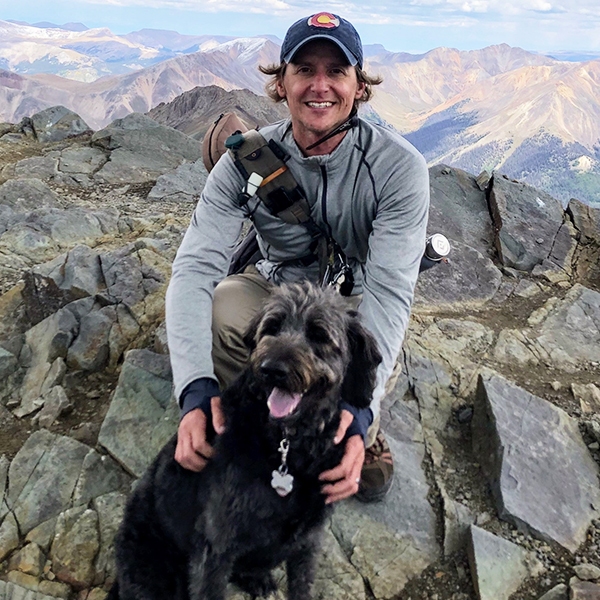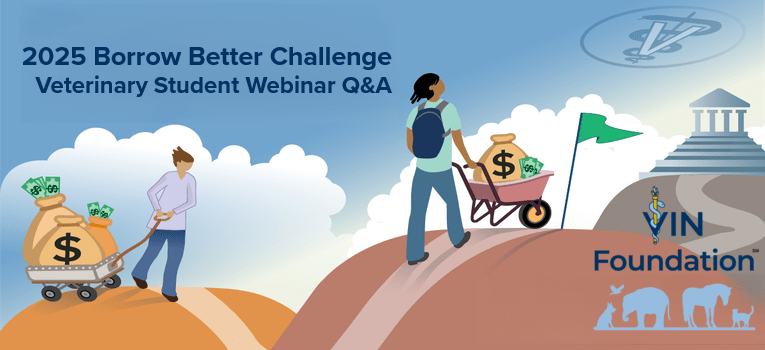Didn’t catch the 2025 Borrow Better Challenge webinar? No problem! We’ve summarized the key takeaways in this Q&A resource. Quickly find your question and a concise answer, or watch the relevant clips from the recording for more in-depth information.
Borrowing During a Changing Landscape
Q: If I were to take out a small loan before the July 2026 deadline to continue borrowing under the previous borrowing limits, is there a minimum amount that can be taken out?
A: There is no stated minimum amount for Direct Loans. The recent tax and spending law specifies that you must be enrolled in a program and have received a federal loan before July 1st, 2026. Borrow only what you need to cover your tuition and fees for each semester. If you don’t need a loan for this academic year (2025-2026), consider taking a small Direct loan. This may help you to be grandfathered into the existing, more flexible borrowing rules, potentially allowing continued access to Grad Plus loans, which will otherwise be eliminated or capped for future borrowers.
Q: If I have loans taken out before and after July 2026, will the new repayment plans apply to all of my loans?
A: If you receive a loan after July 1st, 2026, according to the updated law, you will be limited to only the new Repayment Assistance Plan (RAP) as your income-driven option. This applies to most students graduating after 2026. While RAP has beneficial features (like a 100% unpaid interest subsidy), it requires 30 years to reach forgiveness, which is a major difference from existing plans.
Borrow Better Challenge video segment: 35:11
Q: How do I find a balance between taking out student loans and keeping a healthy savings account? I worked for one year before school and have enough to pay about one year of rent. Should I take extra loans, such as Grad Plus loans, to avoid draining my savings?
A: It is generally not a good idea to wipe out your savings just to avoid student loans. Your savings are valuable for covering emergencies, ancillary expenses, unexpected opportunities, and helping you transition from veterinary school to your first paycheck. Federal student loans are readily available and flexible, especially when starting repayment. There is no compelling reason to eliminate your savings to avoid them. If you have enough assets to cover a significant part of your education and still have savings when you graduate, then using those assets might be worthwhile.
Borrow Better Challenge video segment: 71:35
Student Loan Interest
Q: Is there a way to not accrue interest during veterinary school?
A: No, there is no easy way to avoid student loan interest on Direct Loans during veterinary school. The only federal loans that do not accrue interest while you are in school are Health Profession Student Loans (HPSL) or Loans for Disadvantaged Students (LDS). However, the cost of veterinary school is typically high enough that most students must rely on Direct Unsubsidized Loans and Direct Grad Plus Loans, both of which accrue interest while you are enrolled. Your goal should be to minimize borrowing in the higher interest rate categories to reduce total accrued interest.
Borrow Better Challenge video segment: 29:30
Q: Does interest get added to my principal 6 months after graduation and create a new principal that interest will then be calculated from?
A: No, federal student loan interest does not capitalize (get added to the principal and start generating new interest) upon leaving school, unless you consolidate your loans. Most capitalization triggers were eliminated a few years ago. Federal student loans only charge interest on the principal amount, not on the accrued interest (they do not compound).
Borrow Better Challenge video segment: 57:48
Q: I am interested in paying off some interest while I am still in school, but I am wondering how much would be recommended to really make a difference? Also, how do I go about paying off some of the interest while I am in school?
A: If you have extra cash flow or savings while borrowing, then borrow less rather than making payments towards interest. If you can make payments, it suggests that you borrowed too much. By borrowing less, your principal will be lower, and less interest will accrue, resulting in a lower balance at graduation. If you realize that you’ve borrowed too much, you can return funds within 120 days of receipt with no penalty. Returning (aka canceling) returns the principal, interest, and fees associated with that returned amount.
Borrow Better Challenge video segment: 50:28
Direct Loans & Health Professions Student Loans (HPSL)
Q: If I return federal student loans, where would I see that documented? Is it visible on the Federal loan website or with your servicer?
A: You should check your loan servicer account immediately for a real-time accounting. The student aid file (studentaid.gov) may take around 30 days to reflect the update. When processed, the return should show up in your student aid account as a “canceled amount” or “return” rather than a standard payment. Confirm that the interest and fees were also returned.
Q: Do federal student loans compound?
A: No, federal Direct Loans do not compound. Direct Unsubsidized and Direct Grad PLUS loans charge interest only on the principal balance. The accrued interest is kept in an “unpaid interest” bucket separate from your principal, and no additional interest is charged on that unpaid interest.
Borrow Better Challenge video segment: 54:26
Q: How does the interest rate of the Health Professions Student Loan (HPSL) compare to that of unsubsidized student loans?
A: HPSLs have a fixed interest rate of 5%. They are beneficial because they do not accrue interest while in school, unlike Direct Loans for veterinary school, which accrue interest immediately. Offsetting Direct Loans (currently 7.94% and 8.94% interest rates) with HPSLs helps decrease the total interest accrued during school.
Q: Can anyone apply for an HPSL, or are there specific requirements?
A: You must first ensure your school offers them. HPSLs require a separate application outside of FAFSA and are a need-based loan. You will be required to submit family financial information for a need-based analysis. Since the availability is based on availability at your school, relative need, and the size of the loan pot, you are encouraged to apply even if you are unsure of your qualification.
Borrow Better Challenge video segment: 31:11
Q: Do I have to apply for HPSLs outside of FSA and my institution’s financial aid office? This is the first I’m hearing of it, and I wish I’d known it was an option sooner.
Borrowing for Veterinary Schools Outside of the U.S.
Q: Do loans work differently for schools abroad? Or can I take student loans out the same way I would in the States?
A: Yes, federal student loans work differently for schools outside the U.S. Students attending foreign veterinary schools are not eligible for the expanded Direct Unsubsidized Loan limits that are offered to U.S. health profession programs. This reduction in Direct Unsubsidized limits means that a greater portion of the required borrowing will fall into the more expensive Grad Plus Loan category.
Repayment After Veterinary School & Refinancing
Q: I’ve heard that if you go through the match, you can defer repayment while in an internship/residency. Should I save the repayment money until I’m out of deferment? Or can I still pay a little while technically still deferring?
A: Whether you go through the Veterinary Internship & Residency Matching Program (VIRMP, aka “the match”) or not, you will have the option to defer your student loans. However, deferment during internship or residency training is contraindicated. To give yourself the most flexibility during your advanced training, 1) File a tax return before graduation, 2) apply for an income-driven plan, like PAYE, IBR 2014, or the new Repayment Assistance Plan (RAP), due to be available by July 1, 2026. RAP could be a great choice during advanced training. RAP includes a 100% unpaid interest subsidy, meaning your balance will not grow, and it offers a principal credit (up to $50 per month) in low-payment scenarios, allowing your balance to decrease during your training.
Borrow Better Challenge video segment: 1:23:43
Q: How does loan repayment work if I take an internship year after graduation?
A: To give yourself the most flexibility during your advanced training, 1) File a tax return before graduation, 2) apply for an income-driven plan, like PAYE, IBR 2014, or the new Repayment Assistance Plan (RAP), due to be available by July 1, 2026. RAP could be a great choice during advanced training. RAP includes a 100% unpaid interest subsidy, meaning your balance will not grow, and it offers a principal credit (up to $50 per month) in low-payment scenarios, allowing your balance to decrease during your training.
Borrow Better Challenge video segment: 1:22:50
Q: When I make payments on my loans after graduation, do they still get applied to the interest accumulated first, and only go toward the principal amount after I cover the interest?
A: Yes, payments are applied to accrued interest first. Once your payment covers the total interest generated that month, any remaining amount will be applied to the unpaid interest bucket, and then finally, any remaining amount to the principal amount. If you have a high unpaid interest balance, you will not see the principal balance decrease until that accrued interest is fully paid down.
Borrow Better Challenge video segment: 1:31:49
Q: If I refinanced with a private lender, is there a way to make it go back to federal student loans?
A: No, if you refinance (or previously refinanced) your federal student loans with a private loan, the action is undoable. There is no way to return them to the federal student loan system. Refinancing federal loans is generally discouraged because it makes the debt less flexible and removes benefits like access to Income-Driven Repayment plans and Public Service Loan Forgiveness (PSLF).
Borrow Better Challenge video segment: 1:18:08

Dr. Tony Bartels graduated in 2012 from the Colorado State University combined MBA/DVM program and is an employee of the Veterinary Information Network (VIN) and a VIN Foundation Board member. He and his wife have more than $400,000 in veterinary-school debt that they manage using federal income-driven repayment plans. By necessity (and now obsession), his professional activities include researching and speaking on veterinary-student debt, providing guidance to colleagues on loan-repayment strategies and contributing to VIN Foundation initiatives.

